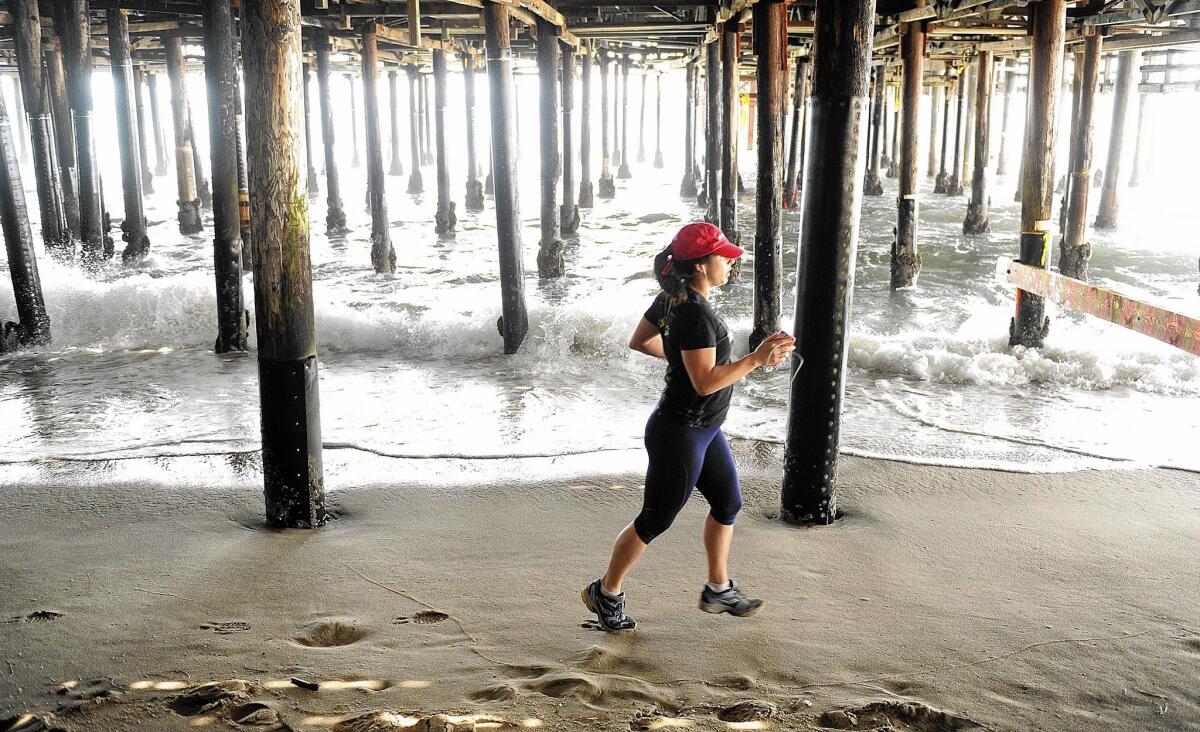Drought has upside: record-low rainfall means cleaner beach water

- Share via
California’s drought has at least one upside: Record-low rainfall has resulted in cleaner water up and down the coast, a new report says.
Ninety-five percent of California beaches earned A or B grades for water quality during the summer of 2013, a 2% improvement over the previous year, according to the annual Beach Report Card released Thursday by Heal the Bay, an environmental group.
The grades ticked up largely because lower amounts of polluted runoff flowed to the coast during the driest year on record, Heal the Bay says.
The analysis used water-quality test results from hundreds of beaches from April 2013 to March 2014 to assign each a grade of A to F based on the level of bacteria in the water, which can indicate pathogens that can sicken swimmers.
The report found improvements even at Los Angeles County beaches, which have long been among the most polluted in the state. Last year 90% of the county’s beaches earned A or B grades, compared with 84% during the previous year’s summer season, which runs from April to October.
The higher grades may seem like encouraging news for beachgoers. However, 2013 was the driest calendar year in 119 years of record-keeping, and the runoff-diminishing effect of several years of low rainfall “may be providing a false sense of long-term beach water-quality improvement,” the report says.
Water quality could turn for the worse if, as predicted, an El Niño develops in the Pacific Ocean later this year, potentially bringing more precipitation to sweep a greater volume of contaminated runoff to California beaches.
Three L.A. County beaches made the report’s statewide list of the 10 worst-polluted “Beach Bummers”: Mother’s Beach in Marina del Rey, Cabrillo Beach in San Pedro and the popular beach at the Santa Monica Pier, which rejoined the list at No. 7 after four years of cleaner tests.
Santa Monica officials blamed the dip in water quality on large rips in netting installed under the pier to keep pigeons from gathering and polluting the water with bacteria-laden droppings. The netting has since been repaired, said Dean Kubani, the city’s sustainability manager.
Poche Beach in San Clemente also earned its way off the list of 10 dirtiest beaches, with city officials crediting a falconer they hired last year to scare away gulls polluting the water with their droppings.
The main beach at the Santa Catalina Island tourist hub of Avalon, which had ranked among the 10 most-polluted beaches for 12 of the last 14 years, escaped the designation this year after city officials spent millions on sewer repairs.
Water quality also continued to improve in Long Beach, which was once notorious for its polluted shoreline. Eighty-seven percent of the city’s beaches earned A or B grades during the summer, up 10% from the previous year, and city officials attributed the gains to infrastructure upgrades to divert and treat ocean-bound runoff.
Other popular beaches improved just enough to be removed from the worst-polluted list but still have a long way to go before they can be considered clean.
“Malibu Pier and Redondo Pier may have missed this year’s Beach Bummer list,” the report says. “However, it is concerning that both locations earned C grades ... during one of the driest years on record.”
For some of the state’s cleanest beaches, Heal the Bay recommends an “honor roll” of 33 that earned A-plus grades for excellent year-round water quality. Among them are The Wedge in Newport Beach, Main Beach in Laguna Beach, Will Rogers State Beach at Pulga Canyon and several beaches in Carlsbad.
The leading cause of water pollution at beaches is urban runoff, which as a result of rain or irrigation sweeps contaminants from lawns, roadways and industrial sites through the region’s creeks, storm drain system and rivers and to the coast.
To address the problem, Heal the Bay recommends local governments adopt new fees and ordinances to build rain- and runoff-capturing infrastructure to prevent contaminated water from reaching the shore.
tony.barboza@latimes.com
Twitter: @tonybarboza







